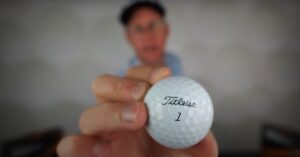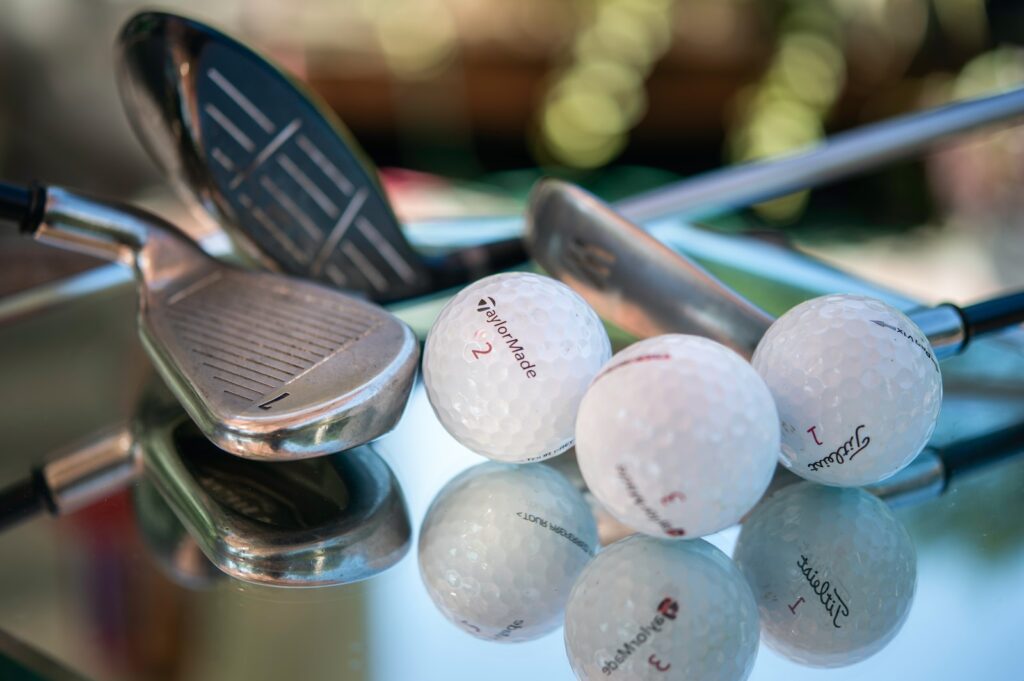why are there 336 dimples on a golf ball?
Have you ever wondered about the mysterious, tiny indentations adorning a golf ball? It’s no decorative choice; each golf ball is meticulously crafted with exactly 336 dimples. Isn’t that oddly specific?
The magic number 336 isn’t random; it’s all about physics! These dimples reduce drag, allowing the ball to fly further than a smooth-surfaced one. In essence, they’re aerodynamic aids.
Ready for some more fascinating facts? Read on to learn how these dimples affect the game’s outcome and why different brands might vary in their dimple count. You’ll be surprised at just how much there is to know about these little dents!

Key Takeaways
- The 336 dimples on a golf ball maximize lift while minimizing drag, enhancing the ball’s flight distance and stability.
- These dimples follow principles of aerodynamics, allowing the ball to cut through air effectively, thus improving its performance.
- A uniform number of dimples ensures consistent behavior in every shot enhancing player’s control over the game.
- The design has evolved over time from smooth balls to ones with 336 dimples for optimal balance between speed and precision.
Why Does a Golf Ball Have 336 Dimples?
The primary reason why a golf ball has 336 dimples is to reduce air resistance, also known as drag, and increase lift. This unique design feature enables the ball to travel further distances with increased accuracy.
Dimples on a golf ball serve an essential purpose in enhancing its performance during play.
The concept of adding these small indentations onto the surface of golf balls was initially discovered serendipitously when golfers noticed that their scuffed or damaged balls seemed to fly farther than new ones.
This led scientists and manufacturers into researching this peculiar phenomenon and eventually incorporating it into modern golf ball design.
Dimples work by disturbing the air around the golf ball, reducing the drag which slows down smooth objects as they move through the air.
Without dimples, a perfectly smooth golf ball would experience significant turbulence at its rear end as it flies, creating high-pressure drag that drastically reduces distance and speed.
How golf ball Dimples Enhance Lift?
Besides reducing drag, dimples also enhance lift. As a spinning object moves through fluid (air), it generates lift due to what’s known as Magnus effect – a principle commonly seen in flying discs or frisbees.
Likewise, for spinning golf balls, dimpled surfaces create subtle turbulence above their equator leading to lower pressure compared to below where there’s less turbulence – resulting in an upward push or lift.
A Closer Look at 336 Dimples on Golf Ball
| Dimple Quantity | Reasoning Behind The Number |
|---|---|
| 336 | Although there is no standard number of dimples on a golf ball, 336 is considered optimal by many manufacturers. This number strikes a balance between maximizing lift and minimizing drag, thus optimizing the flight characteristics of the ball. |
Science Behind the Dimpled Design of a Golf Ball
When looking at a golf ball, one might wonder why it’s not smooth but dimpled. The answer is simple yet fascinating: these small indentations, or dimples, are there to increase the ball’s lift while decreasing its drag as it sails through the air.
The science behind this design involves aerodynamics and fluid dynamics. Let’s explore this more in-depth.
Dimple Design and Aerodynamics
A smooth golf ball travels a short distance because air pressure on the front of the ball is greater than on the back, creating drag that slows down and eventually stops the ball. On a dimpled ball, however, air flows over it unevenly, reducing pressure difference and thus minimizing drag.
Lift Enhancement with Dimples
Dimples also enhance lift by influencing how air circulates around a moving golf ball. The turbulence caused by dimples makes air stick to the surface longer which pushes against gravity and helps keep the golf ball in flight for an extended period.
The Right Number of Dimples
- Balancing Act: More isn’t always better when it comes to number of dimples on a golf ball; an optimal balance must be achieved between too few and too many.
- Matter of Shape: Size and shape also matter; shallow circular depressions have been found most effective in reducing drag without sacrificing lift.
- Sweet Spot: Around 300-500 is considered an ideal range for maximum aerodynamic efficiency based on research conducted by various manufacturers.
How Do Dimples Affect the Flight of a Golf Ball?
Golf ball dimples play a crucial role in determining the flight of a golf ball. They are designed to reduce air drag and increase lift, allowing the ball to fly further and more accurately.
Reducing Air Drag
Dimples on a golf ball work by disturbing the air around the golf ball, reducing its aerodynamic drag. A smooth golf ball experiences significant resistance as it moves through the air, while a dimpled one has an easier passage.
- Boundary Layer: When a golf ball is in motion, air flows over its surface and forms what’s known as a boundary layer. Dimples destabilize this layer causing it to become turbulent earlier than it would with a smooth surface.
- Turbulent Flow: With turbulent flow created by dimples, there’s less drag force acting against the motion of the ball because most of the pressure acts behind or at the rear end where separation occurs later.
Increase Lift
In addition to reducing drag, dimples also create lift that helps keep your shots airborne for longer periods. This lift originates from Bernoulli’s principle which states that faster-moving fluid exerts less pressure than slower-moving fluid.
- Bernoulli’s Principle: As stated before, due to dimples creating turbulence over half of their surfaces; topspin results in lower pressure on top & higher underneath which creates lift – similar how airplane wings work.
- Magnus Effect: The spinning action caused by hitting adds another factor into play – Magnus effect leading not only straighter paths but also further distances achieved due to combined forces of reduced drag plus increased lift.
Dimple Design
The design and pattern of dimples can also influence the flight of a golf ball. Manufacturers have experimented with various shapes, sizes and arrangements to fine-tune performance characteristics like trajectory, distance and spin control.
Dimples on a Golf Ball: Their Impact on Performance and Game Strategy
Understanding the role that dimples play in the performance of a golf ball can provide you with an unexpected edge in your game strategy.
These small indentations are not just for aesthetic purposes; they have a significant impact on how the ball travels through the air, influencing its trajectory, distance, and stability.
The Science Behind Dimples
Dimples on a golf ball serve to reduce drag, which is the resistance experienced by an object moving through a fluid (in this case, air).
They create turbulence in the layer of air around the ball, reducing drag and allowing it to travel further than it would if its surface was smooth.
This aerodynamic principle applies not only to golf balls but also to other sports equipment such as cycling helmets or racing cars.
How Dimples Affect Distance
A properly dimpled golf ball can travel almost twice as far as one without dimples. The reduced friction with air means less energy is lost during flight – meaning more power is retained for distance.
Therefore, choosing a golf ball with efficiently designed dimples could help players achieve greater distances with their shots.
Dimple Design Variations And Their Impact
- Size: Larger dimples may increase lift at slower speeds but can cause higher drag at faster speeds compared to smaller ones.
- Shape: While most common dimple shapes are spherical or teardrop-like, some brands experiment with hexagonal or other polygonal patterns aiming at enhanced performance.
- Density: A higher number of dimpiles increases surface coverage leading to better lift and reduced drag.
Integrating Dimple Knowledge into Game Strategy
Knowing the effect of dimples on a golf ball’s flight can inform your game strategy. For instance, players aiming for long drives might opt for balls with larger and denser dimples as they offer maximum distance.
Alternatively, those focusing on control and precision might choose golf balls with smaller dimples which offer more stability in windy conditions.
FAQs
What is the purpose of having 336 dimples on a golf ball?
The 336 dimples on a golf ball reduce aerodynamic drag and help the ball to fly farther. They create turbulence in the boundary layer around the ball, which decreases air resistance and increases lift.
Do all golf balls have exactly 336 dimples?
No, not all golf balls have exactly 336 dimples. The number can range from 300 to nearly 500 depending on manufacturers’ design preferences for optimizing flight characteristics.
How do the 336 dimples impact a golfer’s performance?
The presence of these specific dimples improves lift force while reducing drag, allowing golfers to achieve longer and more accurate shots with less energy expended.
Could a smooth golf ball perform as well as one with 336 dimples?
A smooth golf ball would not perform as well because it experiences more air resistance, resulting in shorter distances covered compared to a ball with optimal number of dimples such as 336.
| Dimple Shape | Effect on Flight |
|---|---|
| Spherical Dimples | Create stable flight patterns with moderate lift. |
| Oval Dimples | Increase lift for higher trajectories. |
| Mixed Pattern Dimples | Balanced performance with improved distance and accuracy. |

![how many dimples are on a golf ball? [Science behind Dimples] how-many-dimples-are-on-a-golf-ball](https://giftedgolfers.com/wp-content/uploads/2023/01/how-many-dimples-are-on-a-golf-ball-300x157.jpg)


